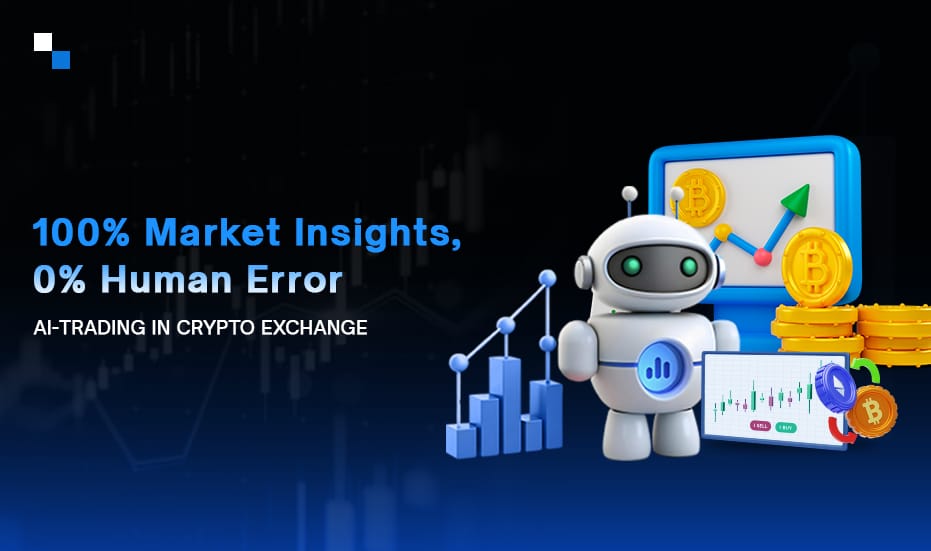
Bitcoin Taproot Upgrade: The Major Innovation
May 10, 2023
An Overview of Components of a Blockchain Ecosystem
May 10, 2023Cryptocurrency has become a widely accepted mode of payment in recent years, and with the rise of digital assets, the need for a reliable and user-friendly exchange has become more important than ever. It is vital for exchange platforms to innovate and stay ahead of the curve to meet the needs of traders. In this blog, we will discuss the importance of user-friendly cryptocurrency exchange software in the cryptocurrency market, the benefits of designing an exchange for all types of traders, and features for next-generation cryptocurrency exchange platforms. Let’s continue reading about the best practices for Cryptocurrency Exchange Platform Development.
Importance of User-Friendly Cryptocurrency Exchange
In the cryptocurrency market, user-friendly exchanges are crucial as they provide a smooth and hassle-free trading experience. A user-friendly exchange platform should offer an intuitive interface, easy navigation, quick access to essential features, and a seamless transaction process.
- Assists Novice Traders in Cryptocurrency Trading
Novice traders face several challenges when entering the cryptocurrency trading world, such as a lack of knowledge, volatile market conditions, and high risks. A user-friendly exchange platform can help novice traders overcome these challenges by providing educational resources, risk management tools, and a simplified trading process.
Designing a user-friendly exchange platform offers several benefits for all types of traders, from novices to experienced. A user-friendly exchange platform provides a streamlined trading process, reduces the learning curve, and enhances the trading experience.
- Fulfills The Need for Innovation
The cryptocurrency exchange industry is constantly evolving, and innovation is vital for the survival of any exchange platform. To stay ahead of the curve, Cryptocurrency Exchange Development Services must constantly innovate and offer new features and technologies.
User-Friendly Design Principles for Cryptocurrency Exchanges
Cryptocurrency exchanges should strive to create a user-friendly design to help novice and experienced traders alike. Here are some user-centric design principles for cryptocurrency exchange platform development:
- Simple and intuitive user interface
A simple and intuitive user interface is essential for new users to understand the platform and navigate easily. The platform should be designed with a clean and clear layout that is easy to read and understand.
- Clear and concise trading information
Cryptocurrency trading can be complex, a clear and concise trading interface with simple graphics and charts can help users visualize the data and make informed trading decisions. The exchange platform should provide users with accurate, real-time data on cryptocurrency prices, market trends, and other relevant information.
- Easy onboarding and account management
New users should be able to sign up and start trading easily, the platform should have an onboarding process with clear instructions for new users. Once the user is onboarded, managing their account should be easy with access to account settings, deposit and withdrawal options, and other relevant information.
- Responsive customer support and resources
Responsive customer support is critical in cryptocurrency exchange software. The platform should also provide users with relevant resources, such as a knowledge base, FAQ section, and educational materials to help users learn about the platform’s features.
Cryptocurrency exchange development should provide quick and efficient customer support through various channels such as email, chat, and phone that can help build trust in the platform and foster a sense of community among traders.
- Multi-Currency Support
Next-generation exchange platforms should support multiple cryptocurrencies to cater to traders who prefer to diversify their portfolios. Supporting a variety of cryptocurrencies can help traders take advantage of market movements and reduce risks.
- Mobile Trading Apps
Mobile trading apps are becoming increasingly popular as they allow users to trade cryptocurrencies on the go. Next-generation exchange platforms should offer intuitive, user-friendly mobile apps with all the features available on the desktop platform.
- Artificial Intelligence
Artificial intelligence (AI) is already used in several industries, and it’s no different in the cryptocurrency world. AI can help traders make better decisions by analyzing historical data and predicting future trends. Next-generation exchange platforms should integrate AI algorithms to provide traders with real-time insights and recommendations.
Advanced Trading Features The Exchange Must Have
To stay competitive in the fast-paced world of cryptocurrency trading, cryptocurrency exchange development services should be leveraged to create cryptocurrency exchange that offers advanced trading features. Here are some advanced trading features that can be incorporated into next-generation cryptocurrency exchange platform development:
- High-frequency trading and algorithmic trading capabilities
High-frequency trading and algorithmic trading are advanced trading strategies that can help traders capitalize on market trends and execute trades quickly and efficiently.
The platform should offer high-frequency trading capabilities with low latency and fast order processing times.
- Advanced order types and trading options
Next-generation cryptocurrency exchanges should provide users with advanced order types and trading options. The platform should support limit orders, market orders, stop orders, and other advanced order types.
The platform should also allow users to trade in a variety of cryptocurrency pairs and provide access to trading tools such as candlestick charts, price alerts, and other analysis tools.
- Margin trading and lending features
Margin trading and lending features can enable traders to increase their buying power and make larger trades with borrowed funds.
The platform should also provide users with risk management tools, such as stop-loss orders, to help prevent losses in highly volatile markets.
- Decentralized trading and peer-to-peer exchange
Decentralized trading and peer-to-peer exchange can offer users greater security and privacy by removing the need for a central authority to execute trades.
The platform should also provide users with secure and decentralized wallets to store their cryptocurrency holdings, further increasing security and privacy.

Security and Transparency Features
The safety and security of cryptocurrency exchange platforms is a major concern for traders and investors. Next-generation exchanges need to incorporate advanced security and transparency features to address these concerns. Some of these features include:
- Cold storage and multi-signature wallets
Cold storage refers to the practice of storing cryptocurrency in an offline wallet, making it less vulnerable to hacking attempts. Multi-signature wallets require multiple signatures to access funds, adding an extra layer of security.
- Two-factor authentication and biometric verification
Two-factor authentication adds an extra layer of security by requiring users to provide a secondary form of verification before accessing their accounts. Biometric verification uses unique physical characteristics, such as fingerprints or facial recognition, to verify a user’s identity.
- KYC and AML compliance
Know Your Customer (KYC) and Anti-Money Laundering (AML) compliance helps to prevent fraud and money laundering by requiring users to provide personal identification and financial information before trading.
- Transparency and Auditability
Providing transparency in trading activities and keeping records of all transactions is crucial for maintaining trust and accountability. Advanced features like real-time audit trails and blockchain-based transaction tracking can provide an unparalleled level of transparency and security.
Steps for Developing a Next-Gen Cryptocurrency Exchange
Developing a next-generation cryptocurrency exchange platform requires a comprehensive approach that considers market needs, user experience, and technological advancements.
- Conducting market research and identifying user needs
Understanding market trends and user needs is crucial for developing a platform that meets the demands of traders and investors. Conducting market research, gathering user feedback, and analyzing user behavior can provide valuable insights into what features and functionalities should be prioritized.
- Collaborating with industry leaders and technology partners
Partnering with industry leaders or an experienced Cryptocurrency Exchange Software Development Company can provide access to the expertise, knowledge, and resources needed to build a successful platform. Collaborating with other companies can also help to expand the range of services offered and provide access to new markets.
- Continuously improving and updating the platform to meet market demands
The cryptocurrency market is constantly evolving, and next-generation exchanges need to adapt to stay relevant. Continuously improving and updating the platform with new features, functionalities, and security measures can help to attract and retain traders and investors.
Strategies for Ensuring Liquidity and Market Depth in Cryptocurrency Exchanges
It requires liquidity and market depth to attract traders and investors, promotes price discovery, and ensures a fair and efficient trading environment. Here are some strategies to ensure liquidity and market depth:
- Offering a variety of trading pairs
To attract a broad range of traders, exchanges must offer a diverse selection of trading pairs, inclusive of popular digital currencies like Bitcoin and Ethereum, as well as lesser-known altcoins. This can help increase trading volume and boost liquidity.
- Partnering with liquidity providers
Exchanges can partner with liquidity providers to increase liquidity and depth in the market. Liquidity providers can help ensure that buy and sell orders are efficiently matched, reducing slippage and improving the overall trading experience for users.
- Implementing market-making algorithms
Exchanges can also use market-making algorithms to ensure liquidity and depth in the market. These algorithms can provide liquidity by buying and selling assets at predetermined prices, even in the absence of market demand. This can help stabilize prices and reduce volatility.
- Encouraging user participation through incentives and rewards
To increase trading activity and liquidity, exchanges can incentivize users to participate in the market by offering rewards and incentives for trading and market-making activities. This can encourage users to place more orders and increase trading volume.
- Utilizing market surveillance tools to detect market manipulation
To ensure a fair and transparent trading environment, exchanges must have robust market surveillance tools to detect and prevent market manipulation. This can help prevent price manipulation and promote trust in the exchange.
Concluding Thoughts
The cryptocurrency industry is constantly evolving, and exchange platforms must keep up with the changing landscape to provide traders with the best possible experience.
In today’s fast-paced trading environment, the development of a user-friendly cryptocurrency exchange is critical. Antier, the professional cryptocurrency exchange software development company recognizes the necessity of providing a feature-rich, safe, and efficient exchange for everyone interested in trading cryptocurrency. Antier’s solutions are intended to simplify your trading experience and help you get the most out of your investments. Make a smart choice by employing extensive expertise and a dedication to perfection to create the best Bitcoin exchange software platform to match your needs.



